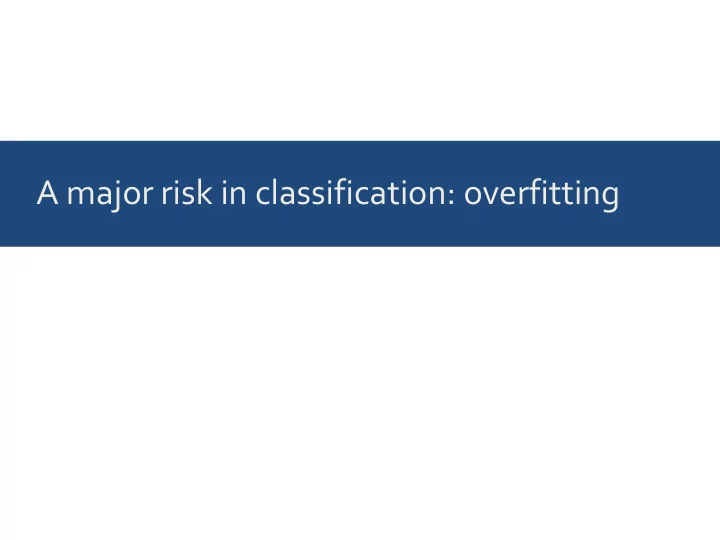

A major risk in classification: overfitting
Assume we have a small data set
We fit a model that separates red and blue red blue
When more data becomes available, we see that the model is poor red blue
A simpler model might have worked better red blue
A predictor always works best on the data set on which it was trained!
Solution: divide data into training and test sets
Solution: divide data into training and test sets Training data Best model for training data
Solution: divide data into training and test sets Test data Evaluate model on test data
Frequently used approach: k -fold cross-validation • Divide data into k equal parts • Use k –1 parts as training set, 1 as test set • Repeat k times, so each part has been used once as test set
Also: Leave-one-out cross-validation • Fit model on n –1 data points • Evaluate on remaining data point • Repeat n times, so each point has been left out once
And: Repeated random sub-sampling validation • Randomly split data into training and test data sets • Train model on training set, evaluate on test set • Repeat multiple times, average over result
Random sub-sampling in R # We assume our data are stored in data table called `data`.
Random sub-sampling in R # We assume our data are stored in data table called `data`. # Fraction of data used for training purposes (here: 40%) train_fraction <- 0.4
Random sub-sampling in R # We assume our data are stored in data table called `data`. # Fraction of data used for training purposes (here: 40%) train_fraction <- 0.4 # Number of observations in training set train_size <- floor(train_fraction * nrow(data))
Random sub-sampling in R # We assume our data are stored in data table called `data`. # Fraction of data used for training purposes (here: 40%) train_fraction <- 0.4 # Number of observations in training set train_size <- floor(train_fraction * nrow(data)) # Indices of observations to be used for training train_indices <- sample(1:nrow(data), size = train_size)
Random sub-sampling in R # We assume our data are stored in data table called `data`. # Fraction of data used for training purposes (here: 40%) train_fraction <- 0.4 # Number of observations in training set train_size <- floor(train_fraction * nrow(data)) # Indices of observations to be used for training train_indices <- sample(1:nrow(data), size = train_size) # Extract training and test data train_data <- data[train_indices, ] # get training data test_data <- data[-train_indices, ] # get test data
Recommend
More recommend